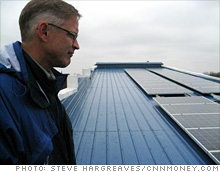Solar farm at Indianapolis airport.
Big utilities try to tilt solar energy market in their favor
NDIANAPOLIS (AP) — Indiana's energy utilities want state lawmakers to pass a law that critics say would muscle out smaller companies from the emerging solar energy market.
Solar power provides only about 1 percent of the country's energy, but it is growing rapidly, with U.S. Energy Department figures showing solar industry employment grew 125 percent since 2010.
Much of the growth has come from homeowners or businesses taking advantage of its bill-lowering potential. That could eventually eat away at the business of the big utilities — in Indiana Duke Energy, Vectren and Indiana Michigan Power — which have a powerful voice and donate handsomely to political campaigns.
Indiana legislators started debate Thursday on a proposed law that in five years would eliminate much of the financial benefit Indiana homeowners, businesses, schools and even some churches reap harvesting the sun's rays.
Republican state Sen. Brandt Hershman's bill would overhaul a practice called "net metering," which allows solar panel owners to feed excess energy into the power grid in exchange for a credit on their power bill.
Hershman's bill would lock in a substantially lower rate of reimbursement than what is currently guaranteed — a move that solar advocates say would make it difficult to break even during the useful life of a solar panel.
"I have nothing against solar. I'm simply trying to reset the marketplace," said Hershman, who says solar panel owners are reimbursed at too-generous of a rate.
But the measure comes as investor-owned utilities across the U.S. are also looking to take advantage of plunging costs for sun-generated power and carve out a share of the market. And critics say the bill amounts to utilities muscling out small companies, threatening the 1,500 jobs the Solar Foundation estimated in 2015 the industry had created in Indiana.
Utilities are also promoting an alternative to installing home solar panels called "community solar" that involves customers agreeing to buy or lease panels from the utilities on large panel farms.
"Utilities like solar if they can control those assets," said Ryan Zaricki, who owns Whole Sun Designs, a solar panel installation company headquartered in Evansville. Zaricki, who employs five workers during busy months, said that if the bill passes "it means that, in the long term, I won't have a business."
Duke Energy Corp., the largest electricity company in the nation, this year plans to launch a "community solar" program in South Carolina and seek regulatory permission to do so in North Carolina, Florida, Kentucky and Ohio, as well as Indiana, utility vice president Melisa Johns said.
Indiana is not the first state to consider a solar industry overhaul. Michigan, Illinois and Iowa are phasing out net metering at a gentler pace, according to advocates. In Maine, Republican Gov. Paul LePage last year vetoed a bill that would have overhauled the state's approach. Montana also is considering policy changes, according to The National Conference of State Legislatures.
Utilities say the current Indiana compensation system is unfair because it requires them to pay solar panel owners for power at retail cost — which is more than it would cost them to produce the energy. They also stress that they own the infrastructure solar panel owners rely on to feed their excess power onto the grid and should be compensated.
"The simple logic for us is if you're using it, you should pay for it," said Mark Maassel, president of the Indiana Energy Association, which represents the largest power utilities.
The solar measure is the latest pushed by Republicans in Indiana, who dominate the Statehouse, which would corner a market, or benefit longtime political allies and campaign donors.
A bill last week that would have effectively blocked electric car maker Tesla from selling in Indiana was overhauled after opposition. Last year lawmakers passed vaping industry regulations that created a monopoly for one security firm that became the sole gatekeeper of who could manufacture the nicotine-laced liquid consumed through vaping. GOP leaders pledged to "fix" the law this year after the FBI launched a probe.
Over the past three years Duke energy and its affiliated political committees funneled $76,000 to state Senate members of both parties.
Hershman has collected $9,000 from the company since 2010, according to state campaign finance records.
The utilities also donated more than $1 million to the Indiana Economic Development Corporation, which helped finance trade missions former Gov. Mike Pence led to several foreign countries in 2014 and 2015, according to data obtained through a public records request. The corporation is a quasi-governmental agency that regularly uses private donations to fund VIP trips for state officials.
___
Associated Press business writer Emery P. Dalesio contributed to this report.







